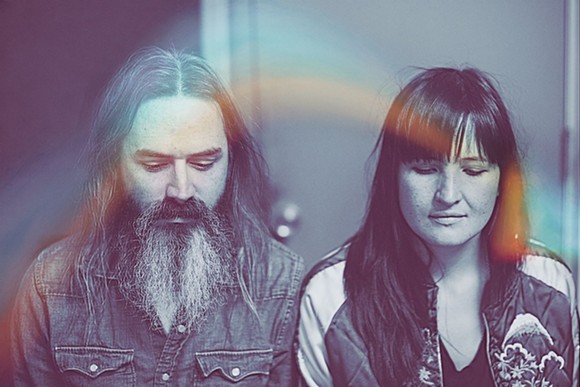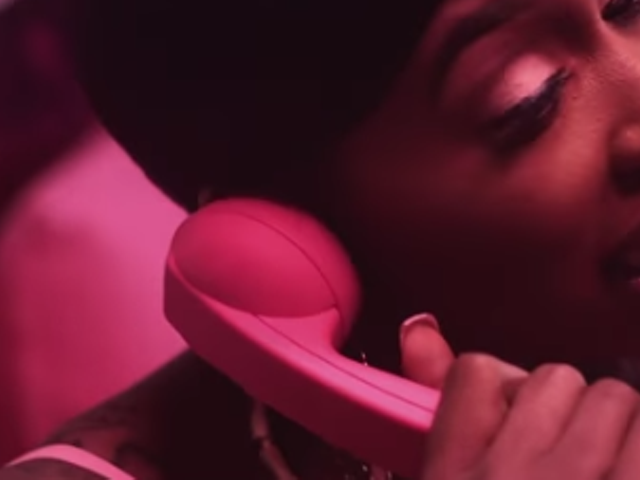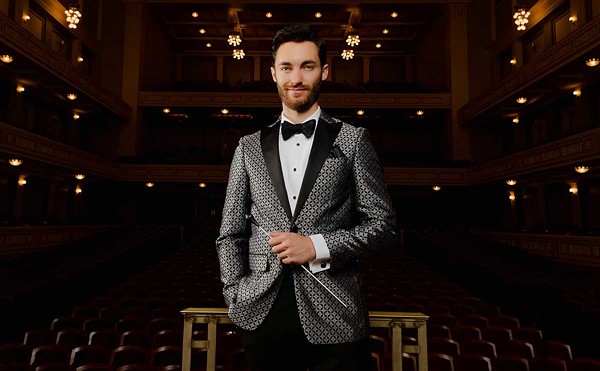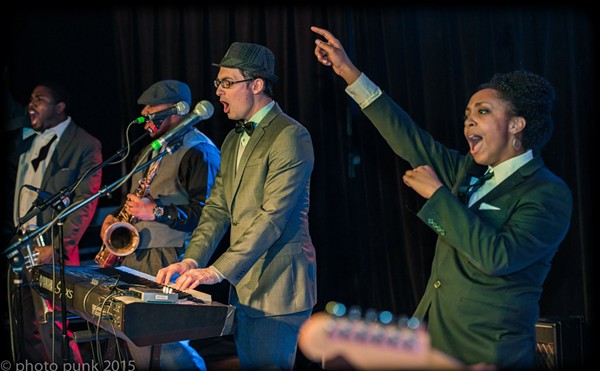Chrome-plated space robots: Why you should be extra stoked today for Moon Duo's show next month
[
{
"name": "GPT - Leaderboard - Inline - Content",
"component": "35519556",
"insertPoint": "5th",
"startingPoint": "3",
"requiredCountToDisplay": "3",
"maxInsertions": 100
}
]
Everyone loves Moon Duo, without reservation. And we could load you up with quotes from other sources to help you feel that you should, also, because these cool and important publications and artists say these things. But if you can listen to the dark majesty of their new release Occult Architecture Vol. 1 and not have your brain at least partially melt upon first listen, then we aren’t sure press quotes are going to help. Their new music is a breakthrough, in terms of sensibility and sound.
Metro Times spoke with Moon Duo in advance of their show at El Club on Saturday, April 22. We asked principal members Ripley Johnson (guitars, vocals) and Sanae Yamada (keyboards, vocals) to walk us through their Occult Architecture album a bit (which, holy shit, did we mention how good it is?), from the conceptual elements to the continued integration of third member John Jeffrey (drums).
PS: True heads might ask the duo to move to their state. Marijuana has been legalized everywhere they have lived (California, Colorado, and Oregon).
FORMAT/ THEME
Ripley Johnson: We started with 12 songs, too much for one LP. But it
also didn’t feel right as a double LP. We didn’t hear our album as a
complete double album experience, like a Phys Graf or Twin
Infinitives. We were also focused on this occult theme. So we had the
idea to group the songs into a “dark” record and “light” record. We
recorded and mixed the songs with that in mind. We mixed the dark
record (volume one) in Berlin and the light record (volume two) in
Portland (in the summer!).
Sanae Yamada: We also really liked the idea of linking the releases to
the seasons they reference, with a time of waiting in between. The
occult architecture concept is more to do with innate, essential
architecture rather than human-made: the intricate, interconnected
patterns that compose the fabric of existence, from the smallest
sub-microscopic particles to the vastness of the cosmos, from the
concretely material to the ethereal. We weren't entirely sure if the
dark/light concept would work out, but the songs really did seem to
develop into two groups as we recorded them.
PROCESS
Sanae Yamada: I was really keen to move away from organ toward
something more electronic, to focus on movement and texture rather
than melodic riffs. Synths offer much more diverse possibilities in
terms of atmosphere.
Ripley Johnson: A good groove should go on as long as it can sustain
itself. That’s another reason we were pushing for the two LPs, to give
ourselves space for that. There’s also the primitive and trance
aspects, but that’s been our thing from the beginning. And lastly, we
just do what we do. We’re not super slick musicians, who are going to
segue into some kind of reggae bridge in the middle of a song. We
can’t do that, and we don’t want to know how to do that.
Sanae Yamada: On a number of songs, we recorded the drums, synth bass,
rhythm guitar, and a synth drones all playing together at Type
Foundry. Then the two of us did overdubs and vocals at home.
Ripley Johnson: We were trying to push our sound this time around. In
addition to the expanded synth role, we were open to really fucking
with everything we recorded. Not just for the sake of it, but I think
we wanted to find a zone that was new for us and didn’t sound like
anything else.
PALETTE
Sanae Yamada: On this record, I wanted the synth parts to be like
textural animals that writhe around one another and react to their
surroundings.
Ripley Johnson: A lot of the vibe of these records comes from Sanae’s
awesome synth. I’m not a synth-pop fan, unless it’s weird or really
lo-fi. Chrome, the Screamers, Throbbing Gristle, Cabaret Voltaire — I
guess that kind of stuff maybe would be influences.
Sanae Yamada: Those bands both employ synths in a visceral way — they
sound alive, and kind of violent at times.
MAN-MACHINE
Ripley Johnson: John Jeffrey, our drummer, is technically a hired
hand, which is how he likes it. But he was there from the beginning
for this album project. He’s Canadian, and lives in Vancouver. For the
last album, he was more of a human drum machine. For this album, we
incorporated a lot of the electronic drum pad work that he does live,
and recorded a lot of improvised fills and things, which extends the
synth soundscape. He’s great. He listens to almost only jazz.
Sanae Yamada: We wanted to add a live drummer without losing the
skeletal consistency of a drum machine, and he manages to pull that
off. For us, musically, it is not so much about man vs. machine, as
about trying to explore the borderlands.
BIKERS
Ripley Johnson: We’ve never played a real biker bar. I’ve never been
in a real biker bar. But we had a flexi single in a really nice NZ
motorcycle ’zine called Head Full of Snakes.
Sanae Yamada: I don't know any hard-core bikers, but I can see how
people who drive for pleasure might dig our music (if indeed they do).
We spend so much time on the road I think the flavor of it, the
craving for that anchorless feeling, seeps into the music. It's
certainly something I think about when we're working on a record. When
we're recording, it's a season of interiors; touring is the season of
outward propulsion. When we're in one season, its opposite moves to
the back burner and becomes a space in the mind.
IF THIS WERE THE SOUNDTRACK TO A FILM…?
Ripley Johnson: Dystopian sci-fi, directed by Jodorowski or Panos
Cosmatos or Shane Carruth, starring…
Sanae Yamada: Starring Charlotte Gainsbourg and Tony Leung! Chrome
Plated Space Robot was our alternate title for it.







